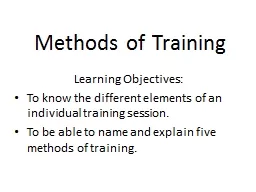

Learning Objectives To know the different elements of an individual training session To be able to name and explain five methods of training Aspects of a Training Session Warmup Fitness or exercise phase ID: 372324
Download Presentation The PPT/PDF document "Methods of Training" is the property of its rightful owner. Permission is granted to download and print the materials on this web site for personal, non-commercial use only, and to display it on your personal computer provided you do not modify the materials and that you retain all copyright notices contained in the materials. By downloading content from our website, you accept the terms of this agreement.
Slide1
Methods of Training
Learning Objectives:
To know the different elements of an individual training session.
To be able to name and explain five methods of training.Slide2
Aspects of a Training Session
Warm-up
Fitness or exercise phase
Skills or team-play phaseWarm-down (cool down)Slide3
Warm-Up
The first phase of a training session.
A
pulse raiser (e.g. light jog) increases heart rate and breathing rate so that oxygen can be supplied to working muscles.
It also allows for psychological preparation.Stretching reduces the possibility of being injured. Cold muscles are more prone to fibre and tendon damage.Warm ups should be specific to the activity.Slide4
Fitness Phase
This phase focusses on one or two components of fitness (e.g. stamina or strength)
The principles of training must be followed.Slide5
Skill Phase
Practice of the skills involved in the game (e.g. netball shooting practice).
This phase could also involve the practice of team tactics etc.Slide6
Cool-down
Each session should finish with gentle activity (e.g. light jog) to cool down.
This helps the body to recover by aiding the removal of lactic acid and other waste products to avoid muscles feeling sore.Slide7
Thresholds of Training
Training sessions should be made specific to the individual.
Factors such as age, experience, fitness levels, ability levels and motivation levels need to be considered.
Training thresholds are used to determine whether training is aerobic or anaerobic.
Aerobic training = 60-80% Max HRAnaerobic training = 80-90% Max HRSlide8
Circuit Training
Circuit training is very popular because it is easy to set up and very flexible.
Circuits involve a series of stations.
Each station should be clearly marked with the exercise accurately demonstrated.
Exercises should be varied and stations which work the same muscle groups should be well separated.Slide9
Circuit Training
Fitness Circuit
Primary aim is to improve fitness.
Exercises could include: press ups, sit ups, skipping,
tricep dips, shuttle runs etc.Requires little specialised equipment and is easy to set up (but may need large space).Skills CircuitAlso uses stations but exercises are focussed on improving skills.E.g. A basketball circuit involving dribbling through cones, lay ups etc.Slide10
Running a Circuit
Timed circuits
– a set time on each station E.g. 30secs. Complete as many exercises as possible in the time. Rest periods
inbetween.
Fixed load – complete a certain number of exercises (E.g. 10 press ups) on each station without a time limit.Varied laps – changing the load or time limit for each lap of the circuit.Slide11
Weight Training
Used to improve muscular strength, muscular endurance and power.
Also improves muscle size, muscle tone and can assist in injury recovery.
Effective weight training involves the principle of overload.
Repetitions – number of times the weight is moved.Sets – a complete set of repetitions.Slide12
Weight Training
To increase muscular strength decrease the number of reps and increase the weight (e.g. 6 reps at near max weight).
To increase muscular endurance increase reps and decrease weight (e.g. 20-30 reps at 40-60% of max weight).
To increase power complete 10-15 reps performed at speed with 60-80% of max weight.Slide13
Types of Weight Training
Free Standing Weights
Cheap and easy to acquire for individuals.
Allows for huge variety of exercises.
Safety issues must be considered and weight training should always be done with a partner.Specialised Weight Training EquipmentOften found in specialist gyms and leisure centres.These can be expensive but are much safer to use.Slide14
Continuous Training
Training which keeps heart rate high over a sustained period of time.
Activities could include jogging, cycling, swimming.
Great for improving cardiovascular fitness.
Easily done in gyms using treadmills, exercise bikes, cross trainers etc.Slide15
Interval Training
Training with periods of high intensity work followed by periods of rest.
Long interval training – work periods of 15s-3mins at 80-85%max effort. Excellent for games players.
Short interval training – short periods of work (up to 15s) but at maximum levels. Longer rest required. Excellent for racket sports and sprinters.Slide16
Fartlek Training
Swedish word for ‘speed play’
Form of interval training including walking, jogging and sprinting.
Continuous Shuttle Run
The multi stage fitness test (bleep test)A fitness test but can also be used as a method of continuous training.Slide17
Altitude Training
Aerobic exercise performed at high altitude.
At altitude the pressure of oxygen is lower so it is harder to get oxygen to the working muscles.
The body compensates for this by creating more red blood cells to improve the oxygen-carrying capacity of blood.
This leads to great improvement when back at sea level.Used by endurance athletes.